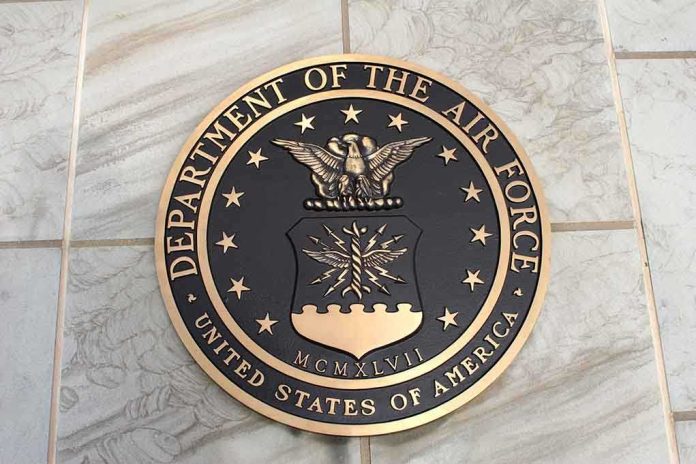
The Air Force’s decision to return nearly 8,000 sidelined M18 pistols to service after a tragic shooting highlights the intense scrutiny facing military firearms—and raises pressing questions about government transparency, accountability, and the protection of fundamental rights.
Story Highlights
- The Air Force paused use of all M18 pistols after a Wyoming airman was fatally shot, triggering a rare force-wide inspection.
- After examining nearly 8,000 pistols, investigators found no evidence of mechanical failure, clearing most M18s for service.
- The civilian P320, similar to the M18, has faced lawsuits and public scrutiny over alleged accidental discharges.
- The Air Force pledged greater transparency and improved inspection protocols but continues its legal investigation into the incident.
Air Force Response to the Shooting and Immediate Safety Actions
The shooting death of Airman Brayden Lovan at F.E. Warren Air Force Base forced the Air Force to take unprecedented action, grounding every Sig Sauer M18 sidearm for urgent inspection. The Air Force Global Strike Command, overseeing security for critical national defense assets, ordered a comprehensive review of nearly 8,000 pistols. This response underscored the gravity of the incident and the government’s responsibility to ensure the safety and reliability of weapons issued to those guarding America’s most sensitive sites.
The Air Force’s rapid move to halt M18 pistol use at all affected bases reflected heightened concern for personnel and public trust. Within a day of the fatal incident, the command initiated a force-wide pause, followed by a broader inspection of 125,000 sidearms. Just weeks later, after a thorough examination, the Air Force announced it had found no evidence of mechanical malfunction in any of the M18s. Out of 7,970 pistols reviewed, 191 showed excessive wear and were marked for repair, while the rest were returned to duty. This process demonstrated both the scale of the government’s response and the importance of transparent communication with the public.
Weapon Safety Controversy and Civilian Parallels
The Sig Sauer M18 is the military’s compact variant of the Modular Handgun System, replacing the Beretta M9 and based on the civilian P320 platform. The P320 has been dogged by lawsuits and allegations of accidental discharges, raising alarms among gun owners and Second Amendment advocates about reliability and safety. Although Sig Sauer maintains the pistol is safe when handled correctly, and the military version passed all required drop and endurance tests, skepticism remains—especially given that the civilian P320 has seen legal action over claims of unintentional firing. The Air Force’s inspection found no evidence that any M18 fired without a trigger pull, echoing Sig Sauer’s assertion and reinforcing trust in the sidearm among many service members and firearms experts.
The Air Force’s transparent handling of the incident provides a rare glimpse into how the military investigates potential weapons failures. Leadership publicly affirmed that no M18 discharges resulted from mechanical faults, and Sig Sauer seized on the clearance as validation of its safety claims. This approach not only reassures the troops but also preserves the reputation of a key defense contractor and supports the rights of law-abiding gun owners who rely on similar platforms.
Legal Proceedings and Accountability for the Tragedy
While the M18 itself was cleared, the legal fallout from the shooting continues. One airman has been charged with making a false official statement, obstruction of justice, and involuntary manslaughter. Military authorities have withheld specific details pending legal proceedings, but this action signals the Air Force’s commitment to upholding military justice and accountability. The Office of Special Trial Counsel has taken charge of the prosecution, ensuring that the investigation’s outcome is not only transparent but also consistent with constitutional protections and due process rights.
The incident has prompted the Air Force to implement improved inspection and reporting protocols for its sidearms going forward. Security forces at strategic bases, including those overseeing nuclear assets, now face increased scrutiny regarding their weapons handling procedures. In the long run, these changes may influence how all branches of the military approach firearm safety, inspection standards, and public communication following high-profile incidents.
Broader Implications for Military Procurement, Civil Liberties, and Public Trust
This episode exposes the ongoing tension between government oversight, public safety, and constitutional rights in an era of heightened political and cultural division. The Air Force’s decisive response—grounding thousands of sidearms, conducting transparent inspections, and openly communicating results—stands in contrast to the bureaucratic opacity and slow-walked accountability often seen in government. For conservatives wary of government overreach and threats to the Second Amendment, the rigorous process and public reporting offer reassurance that rights and responsibilities are being balanced, not undermined.
Air Force Unit Puts Sidearm Back in Service After Shooting Death of Airman #news https://t.co/ppKZjMfJ82 via @epochtimes
— Filtered News (@filterednews) August 26, 2025
Looking ahead, the Air Force’s experience with the M18 will shape future procurement policies, inspection protocols, and risk management procedures. The incident also serves as a reminder of the importance of vigilance in defending constitutional liberties—especially when public safety, individual rights, and American values are at stake in the face of growing calls for government intervention and regulation.
Sources:
Sig M18 Pistol Returned To Service By Air Force Global Strike Command
M18 Pistol Back In Action: Air Force Global Strike Command
Air Force Review: M18 Pistols in Wyoming Repaired and Back in Use
After Fatal Wyoming Incident, Sig Sauer M18 Pistol Back in Use at Air Force Bases
Air Force Unit Puts Sidearm Back in Service After Shooting Death of Airman



